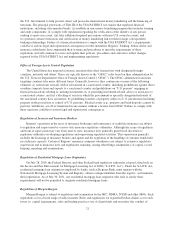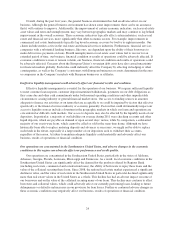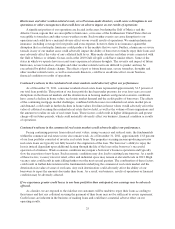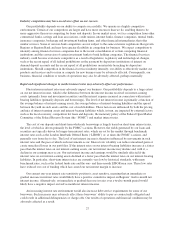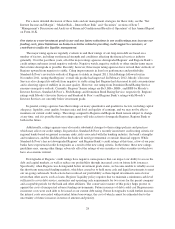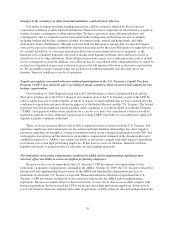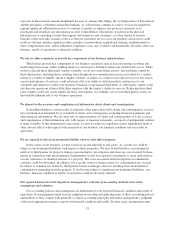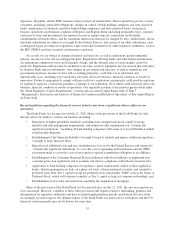Regions Bank 2011 Annual Report Download - page 49
Download and view the complete annual report
Please find page 49 of the 2011 Regions Bank annual report below. You can navigate through the pages in the report by either clicking on the pages listed below, or by using the keyword search tool below to find specific information within the annual report.Hurricanes and other weather-related events, as well as man-made disasters, could cause a disruption in our
operations or other consequences that could have an adverse impact on our results of operations.
A significant portion of our operations are located in the areas bordering the Gulf of Mexico and the
Atlantic Ocean, regions that are susceptible to hurricanes, or in areas of the Southeastern United States that are
susceptible to tornadoes and other severe weather events. Such weather events can cause disruption to our
operations and could have a material adverse effect on our overall results of operations. We maintain hurricane
insurance, including coverage for lost profits and extra expense; however, there is no insurance against the
disruption that a catastrophic hurricane could produce to the markets that we serve. Further, a hurricane or severe
tornado in any of our market areas could adversely impact the ability of borrowers to timely repay their loans and
may adversely affect the value of any collateral held by us. Man-made disasters and other events connected with
the Gulf of Mexico or Atlantic Ocean, such as the 2010 Gulf oil spill, could have similar effects. Some of the
states in which we operate have in recent years experienced extreme droughts. The severity and impact of future
hurricanes, severe tornadoes, droughts and other weather-related events are difficult to predict and may be
exacerbated by global climate change. The effects of past or future hurricanes, severe tornadoes, droughts and
other weather-related events, as well as man-made disasters, could have an adverse effect on our business,
financial condition or results of operations.
Continued weakness in the residential real estate markets could adversely affect our performance.
As of December 31, 2011, consumer residential real estate loans represented approximately 34.5 percent of
our total loan portfolio. This portion of our loan portfolio has been under pressure for over four years as recent
disruptions in the financial markets and the deterioration in housing markets and general economic conditions
have caused a decline in home values, real estate market demand and the credit quality of borrowers. The effects
of the continuing mortgage market challenges, combined with decreases in residential real estate market prices
and demand, could result in further declines in home values. Declines in home values would adversely affect the
value of collateral securing the residential real estate that we hold, as well as the volume of loan originations and
the amount we realize on sale of real estate loans. These factors could result in higher delinquencies and greater
charge-offs in future periods, which could materially adversely affect our business, financial condition or results
of operations.
Continued weakness in the commercial real estate markets could adversely affect our performance.
Facing continuing pressure from reduced asset values, rising vacancies and reduced rents, the fundamentals
within the commercial real estate sector also remain weak. As of December 31, 2011, approximately 13.8 percent
of our loan portfolio consisted of investor real estate loans. The properties securing income-producing investor
real estate loans are typically not fully leased at the origination of the loan. The borrower’s ability to repay the
loan is instead dependent upon additional leasing through the life of the loan or the borrower’s successful
operation of a business. Weak economic conditions may impair a borrower’s business operations and typically
slow the execution of new leases. Such economic conditions may also lead to existing lease turnover. As a result
of these factors, vacancy rates for retail, office and industrial space may remain at elevated levels in 2012. High
vacancy rates could result in rents falling further over the next several quarters. The combination of these factors
could result in further deterioration in the fundamentals underlying the commercial real estate market and the
deterioration in value of some of our loans. Any such deterioration could adversely affect the ability of our
borrowers to repay the amounts due under their loans. As a result, our business, results of operations or financial
condition may be adversely affected.
If we experience greater credit losses in our loan portfolios than anticipated, our earnings may be adversely
affected.
As a lender, we are exposed to the risk that our customers will be unable to repay their loans according to
their terms and that any collateral securing the payment of their loans may not be sufficient to assure repayment.
Credit losses are inherent in the business of making loans and could have a material adverse effect on our
operating results.
25








